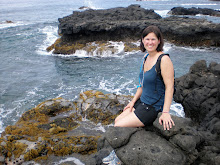One new thing I have learned in this module.... I was interested to see there were so many distinctions for mal-ware and mal-users. I previously would have classified anyone doing wayward things to/with a computer as either a hacker or an unauthorized user, and I thought that any program that went on a computer and did bad things was a virus. I don't know that it will make a difference, but I'm glad to know the difference.
Another thing that impressed me was the information that any computer is vulnerable to attack. I have a MacBook, and have always had a sense of security, because there just aren't Mac viruses. After this module, I thought about it, and realized there are many more Macs out there than there used to be, and people are probably starting to target them. So I downloaded the McAfee virus detection program for MacIntosh computers - FYI, this is available for free to University of Utah students through campus software licensing.
Wednesday, April 27, 2011
Monday, April 11, 2011
Decision Support
How did the readings influence your perception of your own clinical decision-making?
In many ways the readings validated my methods of decision making. I tend to rely on multiple methods to guide my practice - intuition, objective data, subjective data, decision support tools, consultation with colleagues - I could go on. In reflection, I often avoid heuristic means of judgement.
I used to work in a microbiology lab, and identification of organisms can take days, and is reliant on microscopic appearance, gross morphology on an agar plate, biochemical tests, smell, etc. I had a close call with misjudgement early in my micro career. I had an organism growing on an agar plate which grossly resembled Staphylococcus aureus. The confirmatory test for S. aureus is a coagulation test using a rapid reagent (you mix a clump of the bacteria with the reagent, and the reagent coalesces into gray particles). After happily confirming the bacteria as S. aureus, I stamped out a plate of antibiotic disks - and was very surprised the next day to see that it was resistant to vancomycin - something which would be an incredible, CDC reportable occurence with a S. aureus strain. I reflected (before calling the CDC) and knew where I went wrong - I had never done a gram stain on the original isolate. The young colonies "looked" like S. aureus - but if I had done a microscopic examination, I would have seen gram negative rods - the isolate was, in fact. Escherichia coli!! Fortunately this did not result in an adverse outcome - the antibiotics the physician was using to treat the reported "S. aureus" were also effective against E. coli, but it could have had serious consequences if, for example, the patient had a CNS infection which was incorrectly treated, even for a day.
I never, never, never relied on my "gut" again, and instead relied on the tried and true step by step methods for identification, and that methodology has carried forward into my nursing practice as well. For example, I could never be an ER or OR nurse. Instead I am drawn to specialties such as post-partum care, hospice, oncology - where I can make methodical decisions and take my time.
Subscribe to:
Posts (Atom)
